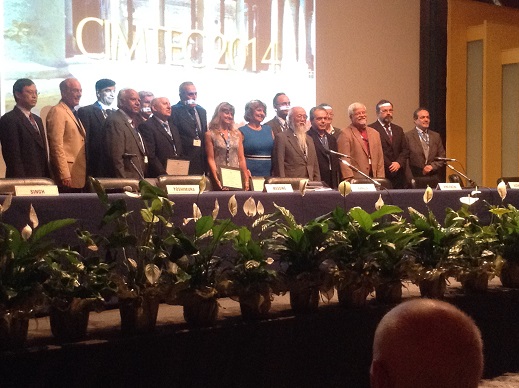
On the morning of June 09th, in the Italian district of Montecatini Terme, the Materials researcher Reginaldo Muccillo, managing director of our SBPMat from 2012 to 2013, was sworn in as member of the World Academy of Ceramics (WAC). WAC is an international entity, with its main office located in Italy, dedicated to promoting progress in the field of ceramics, as well as to spread awareness regarding the social impact and cultural interactions offered by science, technology, history and arts in the field of ceramics.
Reginaldo Muccillo was one of the seventeen selected members in the 15th election process conducted by the WAC academicians, which recognizes the merit of those who substantially contributed to the field of ceramics. Being the only Brazilian member elected this time, Muccillo shared the induction ceremony with researchers and other professionals from China, Spain, the United States, Finland, Italy, Japan, Poland, Portugal and Sweden. The ceremony was held during the opening session of the International Conference on Modern Materials and Technologies (CIMTEC).
Researcher from the Materials Science and Technology Center of the Nuclear and Energy Research Institute (IPEN), Reginaldo Muccillo earned his undergraduate, Master’s and Doctoral degrees in Physics, at the University of São Paulo (USP). He did research stages abroad, first at the National Research Council in Ottawa (Canada) during his Doctorate, then, during his postdoctoral studies, at the Max Planck Institut fuer Festkoerperforschung, in Stuttgart (Germany) and the Institut National Politechnique de Grenoble (France). He was the (co) coordinator of seven issues of the Brazilian Electroceramics Symposium, the VII SBPMat Meeting (2008), and the 6th International Conference on Electroceramics (ICE 2013). He has been the main editor of the journal Cerâmica, an official publication of the Brazilian Association of Ceramics (ABCeram) for 15 years. He holds a 1A-level fellowship for research productivity in the Brazilian Council for Scientific and Technological Development (CNPq).
What follows is a brief interview with the scientist:
Tell us a bit about your history: what led you to become a scientist and work in the field of ceramic materials?
Already in my undergraduate studies, I left the Engineering course in USP’s Polytechnic School to attend Physics. Holding a research scholarship in the field of Nuclear Physics, I met renowned researchers in the USP’s Physics Institute, who effectively influenced me to pursue a scientific career. Once I graduated, I proceed to IPEN, for my Master in Solid-State Physics. Then, when I concluded my Master’s studies, I went to Canada for a research stage beeing part of my Doctorate course. After returning the IPEN, having defended my doctorate at the USP, I started to conduct researches with ceramic materials, moving from Solid-State Physics to Materials Science and Engineering.
In your opinion, what were your main contributions to the field of Materials?
Working in a research institute, I could focus all my time to conduct the research work itself, to raise resources in supporting entities (São Paulo Research Foundation – FAPESP, and CNPq) for improving the infrastructure of the laboratory (I am an experimental researcher dedicated to assembling and collecting data from equipment, analyzing such data and wrinting articles to be submitted to indexed and peer-reviewed journals), to train and instruct staff, to organize events, to edit scientific journals and to interact with the productive sector. In addition to the development of fundamental research in the field of Materials, my expertise allows me to seek applications in devices concerning many industrial sectors.
In your opinion, what are the main challenges to your current research topics in Materials Science and Engineering?
Explaining, modeling and providing theoretical equations to several physical and chemical phenomena that occur in the Ceramic Materials Science.
In your opinion, how did you receive the recognition of the international Ceramics research community, as expressed by your election as a WAC scholar?
Developing research work, training staff at undergraduate, master’s, doctoral and postdoctoral levels, assembling laboratories for the scientific community (multi-users), editing journals (the Cerâmica) in the field of ceramic materials, and researching materials for producing sensors and alternative energy sources, as well as, most recently, flash sintering.
